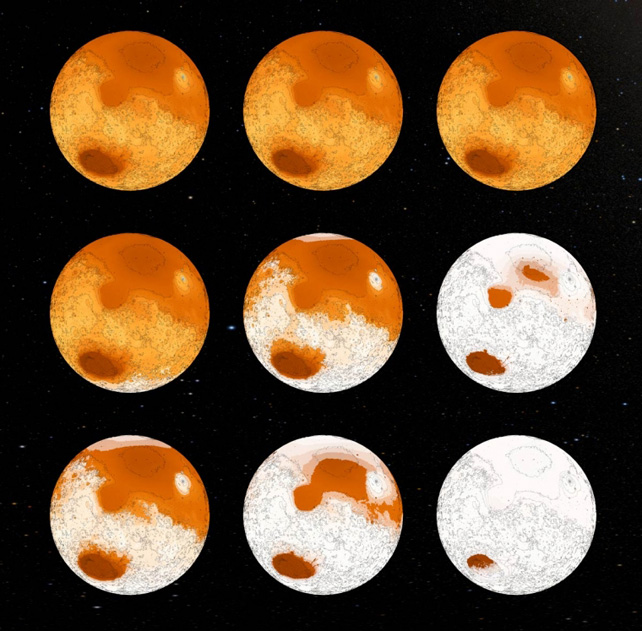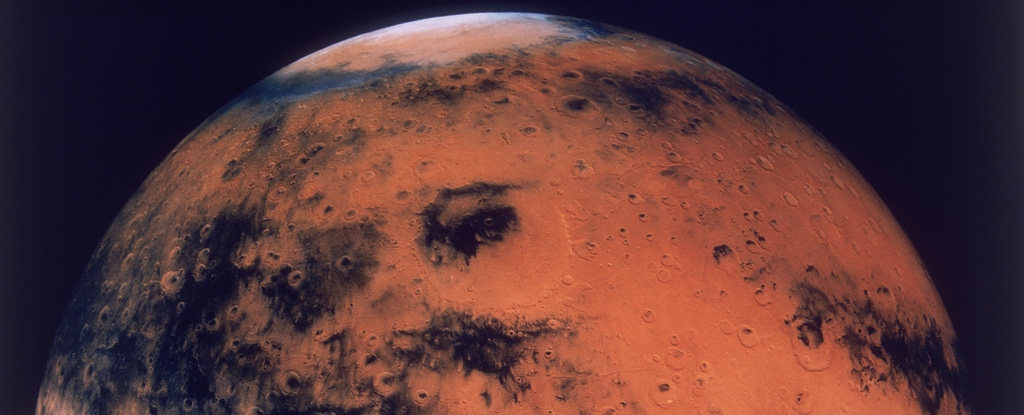Products You May Like
Life might have wiped itself out on early Mars. That’s not as absurd as it sounds; that’s sort of what happened on Earth.
But life on Earth evolved and persisted, while on Mars, it didn’t.
Evidence shows Mars was once warm and wet and had an atmosphere. In the ancient Noachian Period, between 3.7 billion and 4.1 billion years ago, Mars also had surface water. If this is correct, Mars may have been habitable (though that doesn’t necessarily mean it was inhabited.)
A new study shows that early Mars may have been hospitable to a type of organism that thrives in extreme environments here on Earth. Methanogens live in places like hydrothermal vents on the ocean floor, where they convert chemical energy from their environment and release methane as a waste product. The study shows that methanogens may have thrived underground on Mars.
The study is “Early Mars habitability and global cooling by H2-based methanogens.” It’s published in Nature Astronomy, and the senior authors are Regis Ferrière and Boris Sauterey. Ferrière is a professor in the University of Arizona Department of Ecology and Evolutionary Biology, and Sauterey is a former postdoctoral fellow in Ferrière’s group who is now at the Sorbonne.
“Our study shows that underground, early Mars would very likely have been habitable to methanogenic microbes,” Ferrière said in a press release. However, the authors are clear that they’re not saying that life definitely existed on the planet.
The paper says that the microbes would’ve thrived in the porous, briny rock that sheltered them from UV radiation and cosmic rays. The underground environment would’ve also provided a diffuse atmosphere and a moderated temperature that allowed methanogens to persist.
The researchers focused on hydrogenotrophic methanogens, which take in H2 and CO2 and produce methane as waste. This type of methanogenesis was one of the earliest metabolisms to evolve on Earth. However, its “…viability on early Mars has never been quantitatively evaluated,” the paper says.
Until now.
There’s a critical difference between ancient Mars and Earth regarding this research. On Earth, most hydrogen is tied up in water molecules, and very little is on its own. But on Mars, it was abundant in the planet’s atmosphere.
That hydrogen could’ve been the energy supply early methanogens needed to thrive. That same hydrogen would’ve helped trap heat in Mars’ atmosphere, keeping the planet habitable.
“We think Mars may have been a little cooler than Earth at the time, but not nearly as cold as it is now, with average temperatures hovering most likely above the freezing point of water,” Ferrière said.
“While current Mars has been described as an ice cube covered in dust, we imagine early Mars as a rocky planet with a porous crust, soaked in liquid water that likely formed lakes and rivers, perhaps even seas or oceans.”
On Earth, water is either salt water or fresh water. But on Mars, that distinction may not have been necessary. Instead, all of the water was briny, according to spectroscopic measurements of Martian surface rocks.
The research team used models of Mars’ climate, crust, and atmosphere to evaluate methanogens on ancient Mars. They also used a model of an ecological community of Earthlike microbes that metabolize hydrogen and carbon.
By working with these ecosystem models, the researchers were able to predict whether methanogen populations were able to survive. But they went further; they were able to predict what effect these populations had on their environment.
“Once we had produced our model, we put it to work in the Martian crust – figuratively speaking,” said the paper’s first author, Boris Sauterey.
“This allowed us to evaluate how plausible a Martian underground biosphere would be. And if such a biosphere existed, how it would have modified the chemistry of the Martian crust, and how these processes in the crust would have affected the chemical composition of the atmosphere.”
“Our goal was to make a model of the Martian crust with its mix of rock and salty water, let gases from the atmosphere diffuse into the ground, and see whether methanogens could live with that,” said Ferrière. “And the answer is, generally speaking, yes, these microbes could have made a living in the planet’s crust.”
The question became, how deep would you have to go to find it? It’s a question of balance, according to the researchers.
While the atmosphere held abundant hydrogen and carbon the organisms could’ve used for energy, Mars’ surface was still cold. Not frozen like it is today, but much colder than modern Earth.
The microorganisms would’ve benefited from the warmer temperatures underground, but the deeper you go, the less hydrogen and carbon are available.
“The problem is that even on early Mars, it was still very cold on the surface, so microbes would have had to go deeper into the crust to find habitable temperatures,” Sauterey said.
“The question is how deep does the biology need to go to find the right compromise between temperature and availability of molecules from the atmosphere they needed to grow? We found that the microbial communities in our models would have been happiest in the upper few hundreds of meters.”
They would’ve remained nestled in the upper crust for a long time. But as the microbe communities persisted, taking in hydrogen and carbon and releasing methane, they would’ve changed the environment.
The team modeled all of the above and below-ground processes and how they would’ve influenced each other. They predicted the resulting climatic feedback and how it changed Mars’ atmosphere.
The team says that over time, the methanogens would’ve initiated a global climatic cooling as they changed the atmosphere’s chemical makeup. The briny water in the crust would’ve frozen to greater and greater depths as the planet cooled.
That cooling would’ve eventually made Mars’ surface uninhabitable. As the planet cooled, the organisms would’ve been driven further underground, away from the cold.
But the porosity in the regolith would’ve become plugged by ice, blocking the atmosphere from reaching those depths, and starving the methanogens of energy.
“According to our results, Mars’ atmosphere would have been completely changed by biological activity very rapidly, within a few tens or hundreds of thousands of years,” Sauterey said. “By removing hydrogen from the atmosphere, microbes would have dramatically cooled down the planet’s climate.”

The result? Extinction.
“The problem these microbes would have then faced is that Mars’ atmosphere basically disappeared, completely thinned, so their energy source would have vanished, and they would have had to find an alternate source of energy,” Sauterey said.
“In addition, the temperature would have dropped significantly, and they would have had to go much deeper into the crust. For the moment, it is very difficult to say how long Mars would have remained habitable.”
The researchers also identified places on the Martian surface where future missions have the best chances of finding evidence of the planet’s ancient life.
“Near-surface populations would have been the most productive ones, therefore maximizing the likelihood of biomarkers preserved in detectable quantities,” the authors write in their paper. “The first few meters of the Martian crust are also the most easily accessible to exploration given the technology currently embarked on Martian rovers.”
According to the researchers, Hellas Planitia is the best place to look for evidence of this early underground life because it remained ice-free. Unfortunately, that region is home to powerful dust storms and unsuitable for rover exploration. According to the authors, if human explorers ever visit Mars, then Hellas Planitia is an ideal exploration site.
Life on ancient Mars is no longer a revolutionary idea and hasn’t been one for a long time. So the more interesting part of this research might be how early life changed its environment. That happened on Earth and led to the development of more complex life after the Great Oxygenation Event (GOE.)
Early Earth was inhabited by simple lifeforms, too. But Earth was different; organisms evolved a new pathway to harness energy. There was no oxygen in Earth’s early atmosphere, and Earth’s first inhabitants thrived in its absence. Then along came cyanobacteria, which use photosynthesis for energy and produce oxygen as a by-product.
Cyanobacteria liked oxygen, and Earth’s first tenants didn’t. The cyanobacteria grew in mats that created a region of oxygenated water around themselves in which they thrived.
Eventually, cyanobacteria oxygenated the oceans and atmosphere until Earth became toxic to other life. Methanogens and Earth’s other early life can’t handle oxygen.
Scientists don’t quite call the death of all those primitive organisms an extinction, but the word comes close. Some ancient microbes or their descendants survive on modern-day Earth, driven into oxygen-poor environments.
But that was Earth. On Mars, there was no evolutionary leap into photosynthesis or something else that led to a new way to acquire energy. Eventually, Mars cooled and froze and lost its atmosphere. Is Mars dead now?
It’s possible that Martian life found refuge in isolated locations in the planet’s crust.
A 2021 study used modeling to show that there might be a source of hydrogen in Mars’ crust, one that replenishes itself. The study showed that radioactive elements in the crust could break apart water molecules by radiolysis, making hydrogen available to methanogens. Radiolysisysis has allowed isolated communities of bacteria in water-filled cracks and pores in Earth’s crust to persist for millions, possibly even billions of years.
And the Deep Carbon Observatory found that life buried in Earth’s crust contains up to 400 times the carbon mass of all humans. The DCO also found that the deep subsurface biosphere is almost twice the volume of the world’s oceans.
Could there still be life in Mars’ crust, feeding on hydrogen created by radiolysis? There are puzzling detections of methane in the atmosphere that are still unexplained.
Many scientists think that the subsurface of Mars is the most likely place in the Solar System to harbor life, besides Earth, of course. (Sorry, Europa.) Maybe it does, and maybe we’ll find it one day.
This article was originally published by Universe Today. Read the original article.
